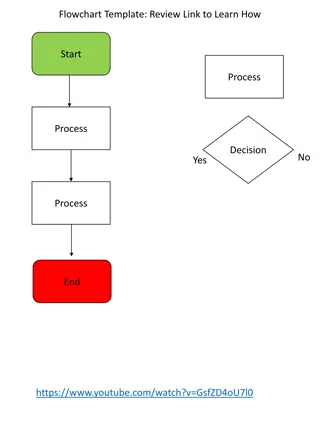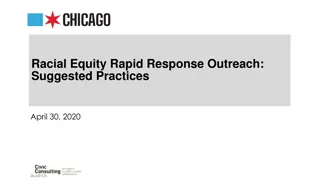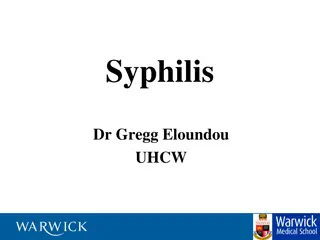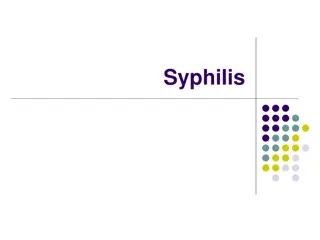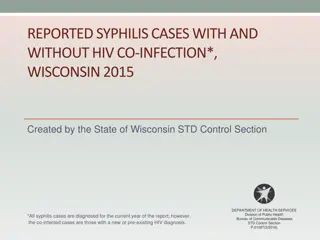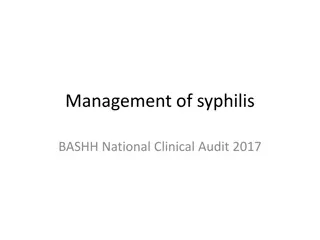Serologic Screening Test for Syphilis: RPR Test Overview
This article provides an overview of the Rapid Plasma Reagin (RPR) test, a serologic screening test for syphilis. It covers the principle, detection of antibodies, antigens used, reagents required, and control serum samples for accurate testing.
Download Presentation

Please find below an Image/Link to download the presentation.
The content on the website is provided AS IS for your information and personal use only. It may not be sold, licensed, or shared on other websites without obtaining consent from the author.If you encounter any issues during the download, it is possible that the publisher has removed the file from their server.
You are allowed to download the files provided on this website for personal or commercial use, subject to the condition that they are used lawfully. All files are the property of their respective owners.
The content on the website is provided AS IS for your information and personal use only. It may not be sold, licensed, or shared on other websites without obtaining consent from the author.
E N D
Presentation Transcript
Ms. A. Fasila Begum Assistant Professor Dept. of Microbiology Jamal Mohamed College
Introduction Serologic screening test for syphilis. Rapid Plasma Reagin test (RPR). It is a macroscopic, non treponemal, flocculation card test. Rapid Rapid test that can be done within few minutes. Plasma The sample is plasma or serum. Reagin Detects antibodies against substances released by the cells when they are damaged by Treponema pallidum.
It detects the Ig M and Ig G antibodies to lipoidal material released from the damaged host cell The lipoprotein like material and possibly caridiolipin released from the treponemes.
Principle The antigen used in RPR is a modified VDRL (caridiolipin) antigen where the particles are coated with carbon or dye. It is a non treponemal slide agglutination test for the qualitative and semi-quantitative detection of plasma reagin in human serum. Carbon particles coated with a lipid complex are agglutinated when mixed with sample containing reagins.
The known RPR antigen consists of cardiolipin, lecithin and cholesterol bound to charcoal particles. Charcoal makes the reaction visible. If the patient has syphilis, the antilipid antibodies (reagin) in patient s serum will cross react with the known RPR lipid antigens giving a visible clumping of the charcoal particles.
Reagents 1. Antigen used in RPR test of 0.03% cardiolipin, 0.20-0.22% lecithin, 0.9% cholesterol, 10% choline chloride, 0.0125M EDTA, 0.01875% charcoal, 0.01M Na2HP04, 0.01M KH2P04, 0.1% thimerosal in distilled water. The antigen suspension is packaged in ampules. Store unopened ampules at 2 to 8 C; do not store the antigen in bright sunlight or in temperatures above 29 C; do not freeze. An unopened ampule of antigen is stable up to the expiration date. RPR antigen suspension is a stabilized combination
2. Control serum samples: Control serum samples are lyophilized reactive (R), minimally reactive (Rm), and nonreactive (N) control serum specimens on a card, or liquid or lyophilized serum samples of graded reactivity. If quantitative tests are to be performed, a control serum that can be tittered to at least a 1:4 dilution should be used. Store control cards or serum samples according to the manufacturer s direction
3. 0.9% Saline. 4. Diluent (control): saline, by diluting a human serum nonreactive for syphilis 1:50 in 0.9% saline Prepare a 2% solution of human serum in 0.9%
Procedure Qualitative method
Semi Quantitative method test sample positive in the qualitative method 1:2, 1:4, 1:8, 1:16,1:32, 1:64, 1:128 and so on as follows: For each specimen to be tested, add 100 L of 0.9% saline into test tubes numbered 1 to 5. Add 100 L of specimen onto test tube 1. Mix the mixture. Avoid formation of bubbles. Transfer 100 L of mixed sample from tube 1 to 2. Repeat this serial dilution procedure in tube 3 to 4, and then 5. Dispose 100 L from test tube 5 after mixing. Perform the qualitative test procedure using each dilution as test specimen. Using isotonic saline prepare serial dilutions of the
RPR test positive (reactive) for Person infected with T. pallidum without symptoms. Other treponemal infection occasionally during pregnancy In acute malaria Leprosy Tuberculosis Viral pneumonia Leptospirosis Cancer Infectious mononucleosis Sometimes after certain vaccination.
Applications It is card test because it is performed in commercially available card. Rapid and cost effective test Result can be visualized macroscopically More sensitive than VDRL Non treponemal test Screening test for syphilis
Limitations Carbon Antigen test. Such reactions sometimes occur in drug abuse and in such diseases as lupus erythematous, mononucleosis, leprosy, viral pneumonia and after smallpox vaccinations. Reactive specimens should be subjected to further serologic study, including quantitation, whenever feasible. The RPR card test cannot be used to test spinal fluids. There will not be a detectable immune response for 14- 21 days after exposure. This test is most useful during the secondary stage of syphilis when the presence of reagin peaks, with typical results >1:32. It is less sensitive to primary syphilis, although there is a low level of <1:16 in about 80% of those who come for medical intervention in the primary stage. False positive reactions occur occasionally with the RPR


